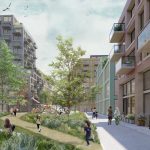A neighborhood where cars don’t drive, children can play in the streets without worry and people meet in neighborhood places. In Utrecht, Hearth of Health, this green and car-free neighborhood is becoming a reality. “This is unique in the Netherlands. We know car-free streets, but a car-free neighborhood on this scale does not yet exist. We want the whole neighborhood to feel like a courtyard. Merwede will be a neighborhood for the future that contributes to the health of its residents.”
The area between the Merwedekanaal and Europalaan used to be on the outskirts of Utrecht, but today, due to the growth of the city, it is in the middle of Utrecht. The new unique neighborhood is all about healthy urban living for everyone. Merwede will be car-free, with plenty of greenery and all city amenities very close by. “We are transforming the business park into a lively area with housing, stores, catering, employment, schools, cultural facilities and healthcare,” says project manager Merwede Finn van Leeuwen.
Healthy environment
According to Finn, it will be a healthy and sustainable environment with lots of greenery. Outside is the place for cyclists and pedestrians, nature and meeting, rest and clean air. “Our aim is a big park with buildings and not a neighborhood with occasional greenery. We are giving the space back to the people.”
Car-free
Over 10,000 people can live in Merwede. “It will be a neighborhood with a large number of residents on about 24 acres. That’s a fairly limited amount of square footage. Therefore, it is important to design the available public space with great attention. This can be done by making the neighborhood car-free. We encourage residents to bike, walk and use shared cars and public transportation.”
Walking or biking
Therefore, everything that neighborhood residents need on a daily basis is within walking or biking distance. “The supermarket and the school is closer to home than the car,” he said. In Merwede, in fact, there is not a parking space for every household. Underground parking garages at the edge of the neighborhood have a total of about 1,800 parking spaces. Against 25,000 bicycle parking spaces in the buildings. According to Finn, Merwede suits Utrecht. “There is already a lot of cycling in our city and a lot of employment opportunities. Moreover, Utrecht is not afraid to try things out. Other cities have not yet been willing to realize a car-free district. The municipality is quite brave in daring to take a big step forward.”
Health gains
By abandoning the car and being mindful of nature, Merwede contributes to a healthy living environment. Physically and mentally. “We are building a better neighborhood than what exists now. In Merwede, people are automatically on the move. Rest and space also contribute to mental health. Among other things, a green environment helps with mental well-being, heat stress and water storage. This approach can yield enormous health benefits.”
Community spirit
He also calls the space for meeting an added value. For example, people from Merwede and surrounding neighborhoods can meet each other at neighborhood spots: two large plazas and a number of small and medium-sized spots created together with residents. “I hope that community spirit is the strength of Merwede. Really together for the neighborhood.”
Area organization
Merwede is getting something else new: a kind of VVE for the neighborhood. Area organization Merwede’s main tasks will include filling in the logistics side with service stores, parcel walls and light electric vehicles, as well as the appointment of one or more neighborhood concierges to serve as eyes and ears in the neighborhood. “You don’t see this yet in other neighborhoods, because residents there don’t share much with each other. In Merwede, the public space is different,” Finn explains.
Sustainability
But not only the approach to urban planning is innovative in Merwede. There are also special solutions in the area of sustainability. For example, the houses will have building insulation made from fungus and wood chips instead of the more traditional rock wool. There are also reusable bricks that snap together, without mortar. And cladding panels that are also solar panels. A thermal storage system that extracts energy from the ground heats and cools the buildings. This also utilizes the heat from the Merwede Canal. As a result, there is a comfortable temperature all year round without drawing on natural resources. Finally, every square inch of roof is used for green roofs, urban agriculture, roof terraces or solar panels.
Merwedelab
In the Merwedelab, the municipality and developers together translate innovative products and ideas into concrete, practical solutions. “For example, how do we turn bicycle parking facilities into places where people enjoy meeting each other?” But there is also a team working on animals and nature to ensure that birds, bats and hedgehogs, among others, find their home in Merwede.
Experiment
Finn sees Merwede as both an opportunity and an experiment. “Realizing a car-free neighborhood isn’t happening anywhere yet. It also raises challenges, such as parcel delivery and accessibility for emergency services. We are all coming up with solutions for that. It’s a fun process. If soon everything works well, we may be an example for other cities. In the Netherlands and worldwide.”








